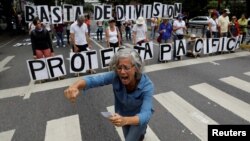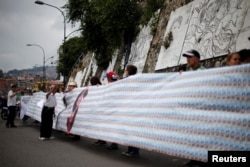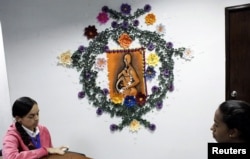Deploying poems, paintings and posters, opposition-minded artists in Venezuela are expanding their anti-government protests, offering a peaceful alternative to the violent political unrest costing at least 90 lives in three months.
"We don't want to confront passers-by but to encourage reflection," said Teresa Mulet, 46, a designer who joined a recent flash protest in a Caracas boulevard, lying with two dozen people as if dead before jumping up to deliver their message.
At the event, lasting just minutes, some shouted phrases lauding peaceful resistance, while others held letters of the alphabet drawn on cardboard which, when joined, spelled a line from a Venezuelan poem: "Those who kill in reality have not lived."
Such surprise demonstrations are organized by a group of intellectuals and artistic creators - from historians to film directors - meeting discreetly since May, sometimes in bookshops, to design different strategies of protests to the traditional street marches.
The organizers break into small groups and appear suddenly at opposition marches or public spaces, including some areas dominated by government supporters, to leave messages that later go viral on social networks.
Near-daily opposition rallies have brought chaos to Venezuelan streets since April as protesters demand elections, solutions to an economic crisis and a suspension of leftist President Nicolas Maduro's plan to rewrite the constitution.
Many have descended into battles between masked youths and security forces, with thousands of injuries and arrests on top of the fatalities. Maduro says the protesters are seeking a violent coup with U.S. encouragement.
Seeking to create arresting images, artists have sometimes turned to gargantuan projects.
In the Venezuelan capital Caracas' largest slum, Petare, they recently unfurled a 25-meter- (82-foot-) wide poster made from 3,000 two bolivar currency notes - worth less than $1 at the street rate - to denounce roaring inflation and economic hardship.
Sometimes, peaceful protesters have been holding up signs, like "Ceasefire!" or "No To Violence!," just meters (yards) from where young men hurl stones and Molotov cocktails against National Guard soldiers using tear gas and water cannons.
At times, the security forces have fired tear gas canisters directly at the peaceful art-themed protest gatherings.
In Barinas, the rural home state of Maduro's predecessor and mentor Hugo Chavez, one painter depicted a pregnant mother with a baby inside her wearing a gas mask - in honor of Venezuela's new generation of young protesters.
Oscar Olivares, a painter and friend of slain student protester Juan Pernalete, mixes the faces of victims with religious images in his protest-themed designs.
"All of us, with our gifts and talents, can build a better Venezuela," said Olivares, some of whose images have been featured on the makeshift shields of young demonstrators. "I'm happy to know my art can provide hope and protection."
The artists, some of whom draw inspiration from Spain's anti-austerity protesters known as "Indignados" ("The Indignant Ones"), are convinced their methods will be more successful than violent protests.
"We're trying to reflect what common people feel," said Mariela Ramirez, 52, an architect.














